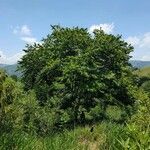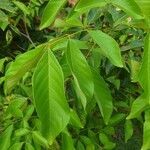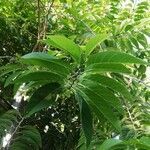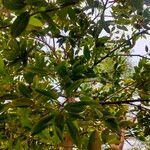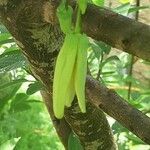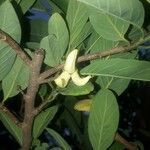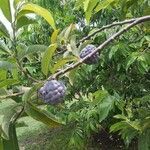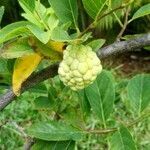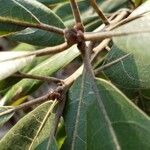Trees, deciduous, to 8 m tall. Bark thin. Branchlets pubescent, glabrescent. Petiole 4-15 mm; leaf blade elliptic-lanceolate, narrowly elliptic, or oblong, 5-17.5 × 2-7.5 cm, thinly papery to membranous, abaxially pale green and puberulent when young but glabrate in age, base obtuse to rounded and slightly decurrent, apex acute to obtuse, lateral veins 8-15 on each side of midvein, adaxially flat. Inflorescences 1-flowered or 2-4-fasciculate. Flowers 2-3 cm, puberulent. Sepals triangular. Outer petals basally green to purple, oblong-lanceolate, 1.5-3 × 0.5-0.8 cm, fleshy, thick, inside concave, keeled on apical half; inner petals absent or reduced to scales, as long as stamens. Stamens oblong, ca. 1 mm; connective broad, apex subtruncate. Carpels oblong, distinct at anthesis; stigmas ovate-lanceolate. Syncarp greenish yellow, slightly pruinose, spherical to ovoid, 5-10 cm in diam., areoles rounded, convex, separated by deep grooves; pulp white. Seeds black-brown, ca. 14 mm. Fl. May-Jul, fr. Jun-Nov.
Tree or shrub to 6 m high. Shoots and branchlets pubescent with grey hairs, glabrescent. Leaves: petiole 7–15 mm long; lamina elliptic, narrowly elliptic, oblong, elliptic-oblong, oblong-lanceolate, lanceolate or obovate, 3.5–17 cm long, 1.8–6 cm wide, acute, obtuse or rounded at base, acute or obtuse at apex, glabrescent; secondary veins usually 5–10 pairs. Flowers few in leaf-opposed cymes; pedicel 10–20 mm long; bracts 0.5 mm long. Sepals very broadly triangular, 1.5–2.5 mm long and wide, sparsely pubescent, glabrescent. Petals greenish yellow, yellowish with a crimson base inside. Outer petals narrowly ovate to oblong, 16–25 mm long, 6–7.5 mm wide, obtuse, puberulous or tomentellous, concave inside at base, keeled towards apex. Inner petals minute or absent. Stamens 1.5 mm long. Carpels partially connate. Syncarpium broadly ovoid to subglobular, (5–) 6–10 cm long, 5–9 (–10) cm wide, somewhat glaucous green; areoles rounded, separated by deep grooves. Seeds 12.5–14 mm long, c. 8 mm wide.
Much branched shrub or small tree 3–6 m. tall.. Leaf-blades oblong, elliptic-oblong, oblong-lanceolate or narrowly elliptic, 7–17 cm. long, 3–5.5 cm. wide, obtuse or subacute at the apex, rounded or cuneate at the base, glabrous above, slightly pubescent or glabrescent beneath; petiole 0.4–1 cm. long.. Outer petals green, purple at the base, oblong, 1.6–2.5 cm. long, 6–7.5 mm. wide, keeled inside; inner petals reduced to minute scales or absent.. Fruits globose or conical, 5–10 cm. long and wide, formed of loosely cohering or almost free carpels, the rounded ends projecting to render the surface tuberculate; surface greenish-yellow with a powdery bloom; pulp white tinged yellow.. Seeds dark brown.
A bushy deciduous tree up to 6 m high. It has irregular spreading branches. The leaves are oblong and narrow, often 12 cm long by 4 cm wide. The leaves have fine hairs underneath. The leaves are dull green and smell when crushed. The flowers droop or hang from branches either singly or in groups of 2 or 3. The flowers are greenish colour. The fruit are 8-10 cm across and greenish in colour. The fruit is covered with round fleshy scales which drop off as the fruit ripens. Inside the fruit are several shiny black seeds about 1.5 cm long. The fruit flesh is white and soft.
